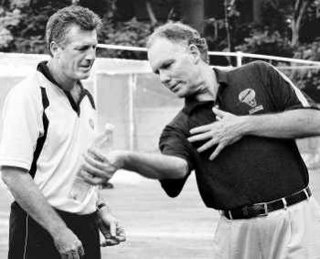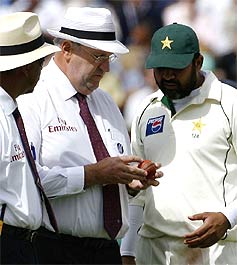 A
Arresting a decay is mostly difficult because it invariably happens in a very unnoticeable, gradual manner. Corruption, for instance, would never have become as acceptable had it happened all of a sudden. Why it succeeded is because it corroded the system over a very long period of time in a very non-intrusive manner.
Yesterday*, surprisingly, a decay reached one of its early summits and I say surprising because unlike corruption or most other decadence that have been witnessed, this one was surprisingly rapid yet there is hardly much murmur about it. And the surprise is all the more because this latest case of decay is taking place in an area we are quite attached with – emotionally and actually.
It was less than two years back that Indian cricket was riding high on the success of Saurav and Wright’s tactics. What was amazing and heart-warming about the team was not so much the success that they were achieving, but the spirit with which they were playing. On a player-to-player basis, this team was no superior than the previous teams which had represented the country. In fact, the shining star of the previous years, and one of the greatest batsman the game has ever seen, was now evidently past his peak. And I think, the best way to gauge the success of this team is from the position of this great player in the team. Saurav’s team became free of Sachin – Sachin was important, he was arguably still the most important player, but that was it. The team’s performance was no longer proportional to the length of Tendulkar’s stay at the crease. The Indian cricket team became what it was always supposed to be one – a team. Each member became important and no one indispensable. Azhar’s boys had been replaced by Saurav’s men.
Watching the dying moments of the match yesterday was an agonizing experience. I could see my spirits and hopes dying – the clock had completed a full circle all too soon. Rahul’s India had become Azhar’s India: Saurav’s India has been thrown into the dustbin of cricketing history all too soon. While there is enough logic and statistics to back the decision of throwing the player Saurav into the bin, there is no logic, cricketing or scientific, to abandon all the good work that he had done. When five boys (read wickets) fell early in Azhar’s India, the game was given up. Saurav’s men fought it till the very end – and more often than not, succeeded. The idea of giving up had been given up.
**************************
An interesting bit of statistic: While chasing an ODI target, if seven or more wickets have fallen, the win record of Ganguly’s team is 1.5 times that of Azhar’s. The importance of this record is realized when you look at a similar record for the Australian team since 1st Jan 1991. Their variance between overall win record and for this filter is less than 20%. For India, it’s close to 35%. Which means, if Australia had a similar record as other team’s for this particular filter, their record for this period, when they have been the unquestioned number one team, would only remain marginally better than the next team. *******************************
You might think that India didn’t give up yesterday after the first five wickets fell early and you are right about it in a very narrow, unthinking manner. Ganguly’s biggest contribution to the team was not recovery but a more tangible phenomenon called success. (See box) Though I have not been able to collect empirical evidence to verify this, India under Ganguly had the best probability of reaching a score of 200 batting first, if the first four wickets fell for less than 50. The idea is that recovering and reaching 150-175, while commendable, did not do much for the end result. The first target for team recovering from a similar position (unless the wicket is a landmine) is invariably 200. Anything less is a defeat – like it happened yesterday. Unlike the paying public’s penchant for close finishes, Ganguly was the kind who would not see a difference between a 16 run loss and a 56 run one. A defeat is a defeat, and it hurts.
Let’s continue the above discussion, with the situation reversing – India defending a total, that is. Except for the odd match, like the Benson & Hedges tie against the West Indies in 1991 at WACA, Azhar’s bowling changes were too defensive and fatal. In this match Azhar did a Ganguly. Defending a meager 126, he went for the jugular – not a single over was given to any irregular bowler though he had only four regular bowlers in his armoury. Tendulkar was brought in to bowl the 41st over only when he had absolutely no choice. But by then the strategy had worked beautifully, with West Indies having lost all but one wicket, and still short by six runs. India won the match, but not before Tendulkar had given away 5 runs. Imagine the result if Azhar had employed his regular strategy. While Kapil, Prabhakar, Srinath and Banerjee had each recorded an economy rate of 3 or under, a few overs by Tendulkar, even if he had scalped a wicket or two, would most probably have been a fatal strategy. But unlike this day of master-captaincy, Azhar was mostly a master at missing the plot. In innumberable cases, when the match was tightly balanced, Azhar’s defensive tactic of getting through with his secondary bowlers first would kill the match long before the spearheads came back into attack.
Ganguly was no genius, just that he was smart enough to learn from Azhar’s mistakes. He didn’t transform the team over night; it was a slow, gradual process. So it is bizarre that the man who thought Dada was next only to God (okay, only in half of the cricket field) should have gone into a complete re-learning mode. Dravid opening the innings would nowhere fit into Dada’s scheme of going for the jugular. Even if we leave Dada aside, a copybook correct Rahul should know that no team puts its best two batsmen at the very top. I am not against innovation or experimentation, but this is plain wrong – cricket is over a hundred years old, one-dayers itself are over a ripe thirty: Certain experiments have already been done and the results well-documented for future reference, you are repeating failed experiments at your own peril.
Saurav succeeded because he learnt from history, he knew the weaknesses that were to be worked on, and the strengths that were to be harnessed. Even he experimented occasionally but never went on an over-drive. Rahul is failing because Chappell seems to have convinced him to start on a blank-canvas. They are following a most weird hit-n-trial strategy. You just need to iron out the wrinkles; a complete plastic surgery may the kill the body.
* Written on the day after the India- Australia match of the DLF Cup 2006, Malaysia







